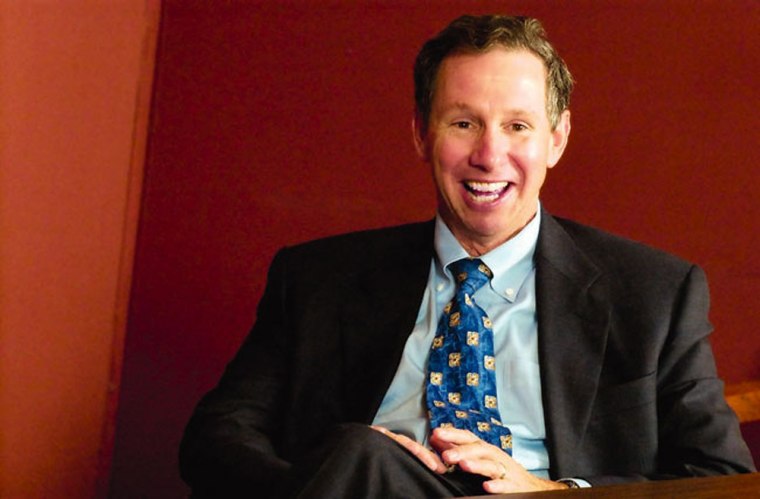The brainy rocket scientist nominated by President Bush and endorsed by key members of Congress to lead NASA as it shifts from space shuttles to moonships seems to have it all and know it all.
But Michael Griffin will need every one of his seven degrees plus political savvy to take on the monumental challenges ahead of him. Getting NASA out of the shuttle business and back into hands-on lunar exploration will clearly be his biggest task.
Already, NASA has told its employees that thousands of jobs may be cut, many of them in aeronautics, in a streamlining effort to achieve the president’s exploration vision. What’s more, Congress has been tepid toward Bush’s moon-Mars plan and questions whether it is affordable and practical, given the war on terror and huge federal deficits.
“Dr. Griffin will need to be bold, decisive and forceful within the agency and a convincing communicator on Capitol Hill,” said the Space Foundation, a nonprofit organization advancing space endeavors. While the foundation has been laid, “Much of the difficult job of transforming NASA remains ahead. Rice bowls need to be smashed, walls torn down, finances put in order.”
Dizzying expertise
Griffin, head of the space department at Johns Hopkins University’s Applied Physics Laboratory, has a Ph.D. in aerospace engineering, five master’s degrees in engineering, physics and business administration, and a bachelor’s degree in physics.
He’s a certified flight instructor who has experience in civil, military and commercial space, as well as with high-tech programs for the CIA. He headed research for the Strategic Defense Initiative, known as Star Wars, and headed exploration for NASA more than a decade ago. He even worked on the Hubble Space Telescope and prototype Mars rovers early in his career, and helped spearhead the first President Bush’s moon-Mars initiative, a short-lived affair.
All this and Griffin is only 55.
It’s enough to make mere mortals dizzy and space enthusiasts giddy.
“If he doesn’t have what it takes, I can’t imagine who does,” said Neil deGrasse Tyson, an astrophysicist and director of the Hayden Planetarium at the American Museum of Natural History in New York.
Tyson was part of a nine-member presidential commission considering Bush’s goal of returning astronauts to the moon by 2020 and ultimately opening up the solar system to human travel.
“If you look at his pedigree, he has hit almost every high point that NASA needs right now to implement and execute this vision,” Tyson said in an interview this week. “You roll all this up into the same person, you’ve hit jackpot.”
Confirmation is likely
The Senate must confirm Griffin’s nomination as NASA’s 11th administrator, and that appears likely. Griffin has declined interviews until he is confirmed. But acquaintances say he wanted the $158,000-a-year job that was vacated last month by Sean O’Keefe, who quit to earn nearly three times more at Louisiana State University as chancellor.
O’Keefe was a budget man and academic brought in to get the spiraling space station budget under control, and he had to learn space on the job.
Griffin has been in the space business from the beginning.
“I am an unabashed supporter of space exploration in general, and of human spaceflight in particular,” he told the House Science Committee in late 2003. “I believe that the human spaceflight program is in the long run possibly the most significant activity in which our nation is engaged.”
At the same hearing, Griffin said he supported sending astronauts to the moon, Mars and asteroids in that order, possibly on nuclear-propelled craft. He also said the shuttle should be replaced “with all deliberate speed.”
What to do with shuttles and Hubble?
The current plan is for NASA to retire its three remaining shuttles in 2010. But Griffin has suggested easing them out even faster to push ahead development of a vessel to ferry astronauts to the space station, the moon and beyond.
Another thorny issue facing Griffin is what to do about the Hubble Space Telescope, nearing the end of its life and doomed unless expensive and risky action is taken to save it.
It is unclear whether Senate confirmation will come in time for Griffin to preside over NASA’s resumption of space shuttle launches, planned for mid-May. O’Keefe’s deputy, ex-astronaut Frederick Gregory, is serving as acting administrator.
Griffin shouldn’t need much prep time.
“He is extremely sound technically,” said John Logsdon, director of George Washington University’s space policy institute and a member of the board that investigated the 2003 Columbia accident. “He’s the kind of person who can look at the preparations for return to flight, and if there are any rats in there, he’ll smell them.”
